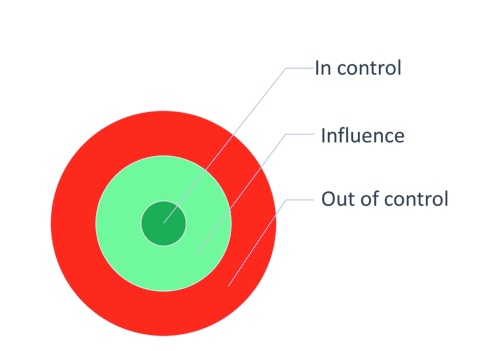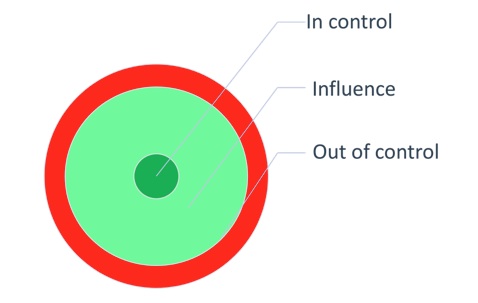
As a Better Boss, I commit to:
Take Responsibility
It’s time for a tough truth: Everything in your life is your responsibility. You’re responsible for your own decisions; you’re responsible for the quality of your relationships; and you’re responsible for your own growth and development.
In a business development role I had some years ago, I was waiting for the head of marketing to respond to a question I’d posed to her via e-mail before I could follow up with a prospect, when one of my colleagues asked me about it.
“Have you made any progress on this?” she asked.
“No,” I griped. “I’m really frustrated. I’ve been waiting for input from Priya in marketing. I’ve e-mailed her a couple of times now, and she just isn’t getting back to me!”
My colleague looked at me thoughtfully and said without missing a beat, “That’s bull.” I was floored for a second. “That shouldn’t stop you,” she went on. “It’s always up to you.”
It was that last sentence that caught me. It’s always up to you. The truth was, waiting on marketing was just an excuse. There was no reason I couldn’t move the sales process forward without her.
It’s always up to you. When you have the guts to own this, to really believe that it is always up to you, you become more engaged in your own life. You stop blaming and pointing fingers. You stop focusing on obstacles and start focusing on solutions. How can you move things forward anyway?
It’s always up to you. If you don’t believe this, you can slip way too easily into the victim mentality. Great leaders never want to be perceived as victims; that’s why, so often, they don’t ask for help. But that’s a fallacy about leadership and victimhood—asking for help doesn’t make you weak or needy; it’s the attitude you have that does. If you take responsibility, if you realize that it’s always up to you, then you also can assess the situation, evaluate your own limits, and know with confidence when you legitimately need help. No one can do everything; knowing what you can and can’t do, and asking for help to make up the difference, is part of taking responsibility and being a true leader.
In contrast, victims don’t ask for help because they know their limits. Rather, victims ask for help because they cling to a “poor me” attitude, are needy, want attention, and/or sadly have given up before even trying. That’s 180-degrees opposite of what a better boss would do.
It’s not the asking; it’s the attitude. Better bosses ask for help with a vision instead of a complaint.
The Circles of Influence and Control
Imagine three concentric circles—one inside another, inside another. The smallest circle inside is the only part of our life we’re actually in control of—ourselves. It’s our thoughts, feelings, emotions, and actions. That’s why it’s the smallest circle.

The outermost part of the three circles represents everything that seems out of our control, such as traffic, bad weather, flight delays, new leadership at our company or in our country, noisy open office environments, or supply chain delays. It’s the economy; it’s a store running out of our favorite product; it’s office politics, relentless competitors, or unresponsive colleagues. (Do I sound like new lyrics for the Alanis Morissette song, “Ironic,” yet?) There are so many things outside of our control—the list is endless. And yet, these are the things we spend so much time obsessing about. What a waste of time!
The second circle, the middle band of the three, is the Circle of Influence. This is where the magic is. Many people mistakenly believe this sphere of influence holds matters that are also outside of their control, so they retreat into their small, center circle. That’s what they know, and that’s where they feel safe. They hide. It’s a response of fear, one that ignores the possibilities of the Circle of Influence. There are ways to make that middle band wider, rather than narrower, but we won’t see how if we’re hiding in the center.
Learning to control our own emotions and fears, and showing up the way we want to show up, is how we affect the inner circle. When we get that under control, then we can play more successfully in the Circle of Influence. That circle is where we might not have control, but we do have influence—i.e., the place where it’s always up to you! Don’t overlook it.

I thought I couldn’t make that sales call because I was waiting on marketing. I thought it was out of my control. But, in fact, that wasn’t entirely true. I could exert my own influence to make the sales call happen anyway. We discussed a similar example during a workshop I taught recently to a group of senior B2B media salespeople who often are stonewalled by clients with the “no budget” excuse. Instead of letting discouragement get the best of us in those circumstances, we talked about ways to influence that included helping their marketing contacts advocate upstream to the CFO (or even CEO, as Salesforce founder Marc Benioff has pointed to as one of their keys to success). In other words, present business-savvy solutions that directly support the organization’s strategic and/or financial objectives and have a clear-cut ROI. There’s rarely budget that can’t be found or reallocated when the right business case exists.
Increasing the width of that middle circle, exercising our influence when we don’t necessarily have control, means being creative. It means being proactive, and not reactive, to our situation.
Part of this is realizing that we have choices. We can choose to continue to behave as though these things are out of our control, or we can choose to influence. There always will be external obstacles and internal, perceived obstacles, but we still can choose which path we want to take. Are we going to choose to let fear hold us back, or are we going to choose to put a leash on fear and drag it along with us? Are we going to allow ourselves to be triggered? Or are we going to pause, question whether we’re making assumptions or taking things personally, and shift perspectives as necessary to ensure success? Are we going to take a dismissive “No” for an answer when we have a win-win solution for a client, or will we choose to influence other decision-makers with confidence and smart business acumen?
We must live with the choices we make; let’s not be so timid that we forget we have them. As an anonymous adage teaches us, “Pain is inevitable, but suffering is optional.”
Excerpt from Chapter 2 of The Better Boss Blueprint by Shani Magosky (September 2017).
Shani Magosky is the author of leadership book, The Better Boss Blueprint. She is an executive consultant and founder of The Better Boss Project, which she developed from years of experience working with bosses at all levels and a desire to put a special focus on changing companies by helping people become better leaders—of others and themselves. Previously, she worked in three divisions of Goldman Sachs, managed a TV station, was COO of an all-virtual international marketing company and launched leadership development consulting and executive coaching practice Vitesse Consulting, where she counsels a range of Fortune 1000 companies, tech startups, entrepreneurs, universities, and nonprofits across multiple industries. She can be reached at shani@thebetterbossproject.com.




